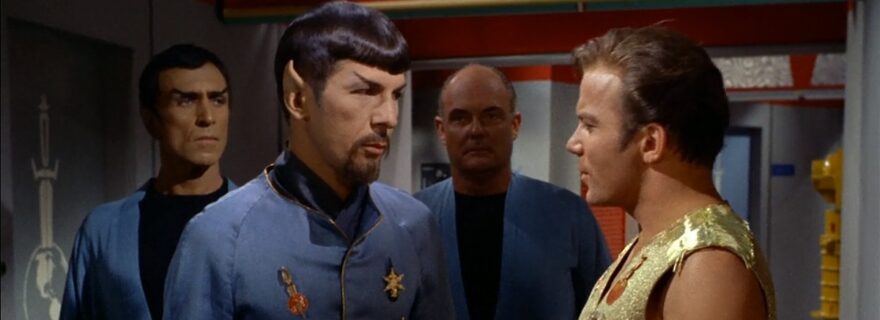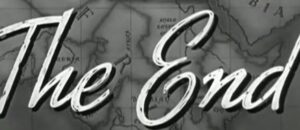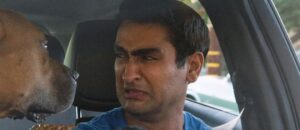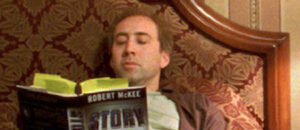With his new horror film Us, Jordan Peele taps into the very primal fear of being threatened or replaced by someone who may look just like you on the outside, but is decidedly different on the inside. This brings to mind some other stories that have dealt with the subject of doppelgängers or evil twins.
Deirdre Crimmins
Thanks to a pesky, recurring childhood nightmare, I’ve always had a healthy fear of doppelgängers and the uncanny. Perhaps it comes down to the fact that you can never fully trust your eyes to tell the difference between good and evil. Perhaps it’s rooted in the fear of the Other, and the terror of not being able to see which person is, in fact, the other. In any case, they creep me out. Recently, the streaming gem Cam might be the best example of why my fear of doppelgängers is an understandable and rational concern.
In the film, the lead character’s likeness is stolen by… something. The plot never dwells on the mechanics of the identity mimicking, but rather shows how devastating and helpless the situation is and fully explores that experience. A woman who makes her living online has her online personality somehow hijacked, leaving her without her livelihood and without her own identity. The flailing feeling of powerlessness is so strong in Cam that it makes me anxious just to think about it.
M. Enois Duarte
This topic immediately brings to mind two of my favorite filmmakers working today: Darren Aronofsky and Denis Villeneuve. Both have made fascinating, convoluted, and thought-provokingly bizarre psychological thrillers centered around the theme of encountering one’s twin stranger. While Villeneuve took a very literal meaning of the word doppelgänger in his underrated Enemy, Aronofsky went for a creepier, more folklore interpretation in his exquisitely beautiful mind-bender Black Swan. The genius of the film, which is essentially a horror allegory for the psychological stress of artistic ambitions and aspiring for perfection, is how Natalie Portman’s dancer Nina confronts her doppelgänger. Fellow ballet dancer Lily (Mila Kunis) is Nina’s perfect competitive match for the lead role in Swan Lake, making her more of a metaphoric double, an evil twin in spirit and alter ego figure that’s more in line to the mythology. On top of that, Aronofsky works closely with talented photographer Matthew Libatique and composer Clint Mansell to create a gorgeous piece of film art that turns ballet into a creepy horror tale.
David Krauss
Decades before plotlines showcasing good and evil twins turned up on almost every daytime TV soap opera, the legendary Bette Davis was doing the twin bit better than anyone ever could or would. Even more impressive, she did it not once, but twice in major motion pictures. Way back in 1946, someone at Warner Bros. pitched the idea that two Bette Davises would be better than one, so why not have the studio’s queen bee portray identical twins in love with the same man? It all came to fruition in A Stolen Life, a slick, sudsy vehicle that afforded Davis the chance to play both sides of the personality and moralistic coin – the shy, insecure, maddeningly placid ingenue and the conniving, bitchy vixen. The “good” twin, Kate, falls in love with Bill (a young Glenn Ford), but before she can properly express her feelings, her manipulative, promiscuous sister Pat seduces and marries him. Kate is heartbroken, but months later the sisters try to make peace and go out boating together. A storm develops, but the reckless Pat refuses to return to shore. The boat soon capsizes and as Pat is washed away, her wedding ring slips off her finger into Kate’s hand. Kate survives, but thanks to the wedding band nestled in her grasp, everyone just naturally assumes she’s Pat. Kate foolishly fosters the charade, stepping into Pat’s shoes so she can have the life she always dreamed of with an utterly oblivious and ignorant Bill. Kate soon discovers, however, that Pat’s marriage is in tatters and her devious, selfish sister has been a brazen, two-timing slut. It all gets sorted out in the end, but not before Davis gets a rigorous emotional workout. A Stolen Life was a huge hit (two Bette Davises really were better than one!) and earned a well-deserved Oscar nomination for its groundbreaking visual effects that allowed the sisters to seamlessly share the screen. It also features two high-quality Davis portrayals.
The whole thing was so much fun, Davis – while enjoying an unexpected career renaissance after the monster success of What Ever Happened to Baby Jane? in 1962 – decided to try the twin thing again. 1964’s wonderfully campy Dead Ringer was the result, and Davis really goes to town as Margaret and Edith, battling middle-aged twins who can barely hide their mutual disdain. Much like A Stolen Life, Margaret stole Edith’s man years ago and has reaped the benefits of his fantastic wealth while the dowdy, blue-collar Edith runs a dingy bar and lives alone in a dumpy apartment above it. The two estranged sisters meet again at the funeral of Margaret’s husband, where the bitter Edith finally sees up close the kind of glamorous, comfortable, privileged life she could have – and should have – had. Edith quickly plots revenge, luring Margaret to her apartment, where she shoots her sister in cold blood, yet stages the crime to make it look like her own suicide! Presumed dead, Edith then masquerades as Margaret and assumes her life, hoping to bask forever in Margaret’s lavish spoils. Instead, she inherits Margaret’s sleazy, sordid mess of an existence and is ill-equipped to handle it. All the while, Edith’s old boyfriend (Karl Malden), who just happens to be a homicide detective, doesn’t buy Edith’s “suicide,” and his snooping adds more stress to Edith’s new life. Davis chews all the scenery with relish, packing both portrayals with her patented clipped speech patterns and distracting but mesmerizing mannerisms, all of which combine to create a couple of captivating over-the-top performances. Dead Ringer is trashy fun from beginning to end, and makes us wish Davis could have played twins in every picture.
Brian Hoss
In the Futurama episode The Lesser of Two Evils, we’re introduced to Flexo, a goatee-sporting variant of Bender. Naturally, evil twin hijinks ensue. Flexo’s plan is to steal the precious jumbonium that the Planet Express crew has been charged with delivering to the Miss Universe Pageant. Fry and, later, Bob Barker, have a tough time telling to two bending units apart. (Magnetic goatees and turtlenecks factor into this confusion.) Of course, Bender is really the more nefarious and more villainous of the two by far, and Flexo is left to pay for Bender’s would-be thievery.
Adam Tyner (DVDTalk)
As nicely as this Roundtable dovetails with the imminent Blu-ray release of Perfect Blue, that’s a lot to explain, and I’ve already written a few thousand words about Satoshi Kon’s masterpiece this week anyway. Let’s take the easy way out instead!
Plenty of duplicates of Ash Williams are skulking around the Evil Dead franchise. A hallucinatory mirror image chokes him in the first sequel. A gaggle of wee, wicked Ashes crawl out of a shattered mirror in Army of Darkness, crawl inside our hapless hero, and spawn the soon-to-be-nightmarishly-scarred Evil Ash.
For my money, the doppelgänger concept is most compelling when two seemingly identical entities compete for the same life, and that’s better explored in the recently concluded Ash vs. Evil Dead TV series. This actually comes up a couple of times.
Spawned from the possessed hand that Ash had severed decades earlier, Evil Ash Mark II pops up in a first season episode with the all-too-appropriate title of Ashes to Ashes. This, unsurprisingly, culminates in the two Ashes standing side-by-side and a “Which one do I shoot?!” conundrum.
One of the major arcs of the series’ third and final season revolves around a hellspawned doppelgänger of Ash. Once he’s grown to full size, Evil Ash Mark III is able to prey upon Ash’s newfound celebrity to rack up a staggering body count. For a brief while, he has a fleshy, demonic chainsaw arm, and that’s just one of the many reasons I love Ash vs. Evil Dead so very much.
Josh Zyber
One of the most fun doppelgänger stories from TV has to be the Star Trek Mirror Universe, first introduced in the 1967 episode Mirror, Mirror. Due to a transporter malfunction, Kirk, McCoy, Scotty, and Uhura are plunged into a bizarre alternate dimension where things may look superficially like the Enterprise they know, but everyone’s an evil space pirate (even Spock!) and goatees are very much in fashion. Although The Original Series sadly never returned to the Mirror Universe, the premise proved to be so popular that the franchise revisited it several times in Deep Space Nine, Enterprise, and most recently Discovery.
For a more sobering meditation on the theme, Andrei Tarkovsky’s 1971 mind-bender Solaris follows a psychologist on a mission to a space station orbiting a mysterious planet. Upon arrival, the planet somehow manifests a duplicate of his dead wife. However, this copy is decidedly incomplete since it was taken from his memories and only represents as much of the woman as he knew about her. It’s a very weird, fascinating movie. Steven Soderbergh’s American remake is pretty underrated as well.
Before we go, I’ll toss in one book recommendation for the hell of it. The Punch Escrow is set in a near future society where teleportation technology is so common that it becomes the default method of mass transit. People use it multiple times a day, even just to hop over to the store a few blocks away. However, the hero of the story discovers a terrible secret – there is no such thing as matter teleportation. The transporter booths actually obliterate the person on the entry side, and 3D print a fresh copy on the receiving end. Is the copy really the same person? That question comes to a head when a terrible accident results in a man’s copy being printed even though the original is never destroyed. Now there are two of him, and the separate events each experiences over the next few days cause them to become very different from one another. The book has some issues with plotting and characterization, and I wish it were a little better written, but its world-building is very good and the central concept is strong enough to be worth a read.
Your Turn
What are your favorite doppelgänger or evil twin stories?





Bolo
‘Face/Off’ had a ton of fun with its concept. John Woo may not achieve the same level of fireworks he did in his Hong Kong movies, but the action scenes are fun and the plot and character moments in between are made incredibly entertaining by two lead actors having an absolute ball. Aside from the setup of a bad guy and good guy swapping identities, they double up on their gimmicks with a magnet-based oil rig prison that probably could’ve been a movie in itself.
Michael Christy
Nicolas Cage’s turn as Charlie Kaufman and his fictitious twin Donald in Adaptation, I would submit as proof that he can actually act quite well. Though not really evil, Donald embodies all that Charlie strives not to be in his art, and Donald’s easy success in the work that Charlie finds soul crushingly difficult is a sort of horror of his brother replacing him and taking away the part of his life that makes him special.
Csm101
Garthe Knight. Best evil twin ever!
Marked For Death- both twins are evil and that makes it cooler.
[email protected]
David Cronenberg’s “Dead Ringers (1988)”.
Robert Mulligan’s “The Other (1972)”.
Ralph Bakshi’s “Wizards (1977)”.
Robert Stokes
Surprised there is no mention of Vertigo.
Shannon Nutt
I guess I should have chimed in this week, as I thought Josh would have almost certainly mentioned the Dale Cooper doppelganger of TWIN PEAKS.
William Henley
I am not much on the evil twin thing, but I like something Josh said in the opening paragraph – “being threatened or replaced by someone who may look just like you on the outside, but is decidedly different on the inside.” This opens up the door to great stories.
On a lighter note, I am going to go with Freaky Friday, The Parent Trap,It Takes Two and Hilfe, Ich Bin Ein Junge. If you want to bring reboots into it, we could say that Hayley Mills is the good twin and Lindsay Lohan is the bad! Seriously though, in The Parent Trap, you literally have two twins that swap places with each other and take on each other’s lives. It Takes Two is pretty much the same premises, except its two identical strangers. It may be The Olsen Twins’ best movie.
As for Freaky Friday and Hilfe Ich Bin Ein Junge, you get into body swap territory (and gender swap in the latter). In both stories, the process of the body swap causes lives to be disrupted so it fits.
On the darker end of the spectrum, I am going with Total Recall, Terminator 2 and <Terminator Genesys. In Total Recall, the agency can not only reprogram you, but turn you into someone completely different, and you would never know the difference, and even if you did, you would not care. It actually brings up the concept of free will – there is a line that goes something along the lines of “Do you like the girl? We can reprogram her and you can eff her as much as you want.” If someone’s mind is reprogrammed, it kind of raises the question about free will, even if the initial programming is against their will, the mind will be changed to an extent that they will not want to be changed back. This brings up the question “are we really just a collection of electrical impulses, and do we still exist if those electrical impulses are changed?” For that matter, “If there is a soul, would that soul be aware of the altered mind, and would it be trapped inside of a body, able to see, feel, hear, taste, but unable to control it?”
Terminator 2 with the T-1000 is spooky – I get killed, machine copies me and takes over my life for the purpose of killing those around me. But that is not as bad as Terminator Genesys which the machines take over a human body and make him do their will.
And going to throw out one last one for the weird. Being John Malkovich. While it starts off just being a doorway to observe life through the eyes of another, it turns into creating events for the observer to be able to witness (there is a rape scene in there. Yeah, go back and watch it, there is a rape scene), followed by eventually total control of the “puppet”. If that is not creepy enough, in the end of the movie, the guy breaks into the mind of a young girl for the purpose of voyerism. Yeah, real messed up movie there.
There are many more I could throw out, but I need to get back to other things, so need to wrap this post up.
EM
Letʼs go with Richard Ayoadeʼs seriocomic The Double (2013), about a schlemiel (Jesse Eisenberg) whose dispiriting job and unrequited love are invaded by a suave duplicate with almost the same name. I enjoy the dual performance and the twisty‐turny relationship between the pair, but in truth what really makes the movie for me is the soul–sucking urban and corporate setting—less 1984 than Brazil, really. Maybe thatʼs a life youʼd want someone to usurp…